
L E C T U R E S . A N D . P R E S E N T A T I O N S
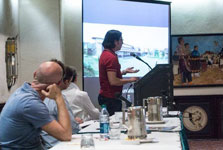
AMERICAN VISIONS - ALTERNATIVE STUDIES
Ceramic Center and craft School Directors
Jean McLaughlin,
Jeff Guido,
Doug Casebeer,
Tyler Gulden,
Stephen Lee
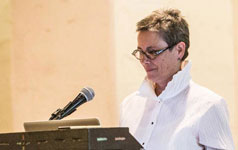
JEAN McGLAUGHLIN
Penland School of Crafts was established in 1929 as an alternative educational resource for the study of crafts. From its start it attracted students from across the county and became a home-base during holidays for many international visitors through the State Department during the 40s and 50s. Today we realize our vision by providing stimulating, creative workshops, residencies, work-exchange programs, a gallery and visitor center, an archives, and community-based programs.
Founder Lucy Morgan built Penland School of Crafts out of an initial desire to help women supplement their family income through crafts. She held a strong belief in the power of creative hand work and encouraging the independently-minded. Both Morgan (1929-1962) and her successor Bill Brown (1962-1982) envisioned and developed a creative retreat for learning in a supportive community environment with craftsmanship at its center. Today, 83 years later, we continue to serve the needs of professional artists and others who want to explore their creative lives.
Penland has between 1300-1400 students annually who come to study with the 130-140 instructors that we invite each year. Our workshops are one, two and eight weeks in length. We have 15 professional teaching studios—which cover the range of media allowing us to teach specialized classes in painting, drawing, bookarts, paper, printmaking, letterpress, photography, textiles, wood, metals, glass, and clay. The work of our instructors and students is sculptural and two dimensional, experimental and classical. We encourage the passing down of techniques and pushing boundaries through experimentation and collaboration.
Our students come from every state in the United States each year as well as 6-15 different countries. We draw our instructors from the faculty of colleges and universities as well as the ranks of accomplished studio artists. In recent years we have had students and instructors from Argentina, Bahamas, Bermuda, Brazil, Canada, Chile, China, Croatia, Denmark, France, Germany, India, Indonesia, Ireland, Italy, Israel, Japan, Mexico, Netherlands, Norway, Puerto Rico, Singapore, South Korea, Spain, Sweden, Switzerland, Taiwan, UK, Venezuela, and Virgin Islands.
Our workshops are intensive with students generally working day and night. About 50% of our students are between 18 and 35 and our student ages range well into the 80s. 45% of our students receive financial aid. Most of our students self-identify as intermediate but we serve many beginners and provide a great laboratory for accomplished artists to try something new. The common denominator among our students is their eagerness to learn. There is a fearlessness and hunger to get as much as they can from their time with us.
Penland is on the National Register of Historic Places as the Penland School Historic District. We draw 17,000 people to campus as visitors or participants in our various programs.
The Resident Artist Program provides a 7 artists with studio, housing and meals (when the dining hall is open) for a three year period of time. The program began in 1963 and created an opportunity for craft artists to hone their skills, develop markets, experiment, build new bodies of work, or possibly move from a career in teaching to one of full-time making. The selection criteria includes artistic excellence, evidence that this experience will significantly affect the artist’s life and career, an understanding that the artist will use Penland to make an important transition. They need to be highly motivated and independent, want to live in a rural community and be self-supporting. Penland invests $12,000 each year in each artist through subsidized housing, studios, meals, and staff assistance. We do not pay the artists an honorarium. The artists pay a nominal amount for housing and studios (just under 200/mo) and cover their own utilities. It was Bill Brown’s belief that artists would use the experience to learn the discipline of running a business and that a subsidized community learning atmosphere was the best organizational approach to help them establish their lives as full-time studio artists. The resident artists interact with the hundreds of studio artists, teachers, and students who pass through the school each year. The program also provides our students with models for living a life in craft. Consistent with Brown’s vision of Penland as the center of a working craft community, Brown also saw the program as a means of encouraging craftspeople to settle in the area. Today, there are over two hundred craft artists working in the area, and forty of them are former resident artists.
The Core Fellowship Program is another extraordinary opportunity for young artists. Established in 1970, Penland’s Core Fellowship Program provides 9 talented artists with a work-exchange opportunity to explore artistic interests and career possibilities in a supportive creative community. Core fellows take classes for two years and receive free room and board in exchange for part-time work. They support the service side of the school’s operation and supervise work-study students.
Penland’s archive holds information, photographs, and historic artifacts that enable us to tell Penland’s story and support research.
Our work in the community has grown considerably in the past 10 years. We have a teaching artist on staff who integrates bookarts and painting projects into the curriculum of the 3rd, 4th and 10th grades in our county school system. Every student who moves through our county school system will have three years of art experiences at Penland. We also offer an advanced art class for high school students and provide mentorships for high school students with area artists. We have worked with the local community college to train teaching artists for residencies in the schools. Recently we started a program called Subs With Suitcases—we have trained area artists to lead any class with an arts activity when the classroom teacher is away. Penland helps to stock the artist’s suitcase with art supplies and has a website that connects teachers with teaching artists. We also participate in local festivals to engage the public in creative activities.
What sets us apart from a college or university, a community college or trade school, a community arts center? What do alternative schools like Penland, Haystack, Arrowmont, Anderson Ranch and Pilchuck offer that differs from other learning environments?
- Retreat environment
- Workshop intensives where one can focus without distraction
- Participating in craft’s oral tradition of passing knowledge down
- In-depth continuing education – curious, committed learners seeking new skills
- Artists working in isolation often want a community experience and feedback on their work
- Students benefit from studying with a particular person
- Artists need access to equipment and studio space
- Artists develop new networks and strengthen existing networks
- Artists gain professional development, professional training, learn from the example of studio artists in the community
- Everyone benefits from multi-generational learning
- Non degree granting institutions attract people who want to learn without grades as motivation
- We offer alternative paths (from advanced university degrees) to studio practice
- We supplement the offerings of one’s primary art department faculty
I will close with a little economic impact information about the craft industry of which we are a part.
- Craft is a $14 billion industry nationally.
- Craft is a $538 million industry in North Carolina.
- Craft is a $206 million industry in Western NC.
- Three craft school programs (Penland, Haywood Community College, and J.C. Campbell Folk School) contribute $11.8 million annual impact in WNC.
- Penland’s direct cash expenditures in NC each year are $5.4 million.
Jean McGlaughlin
is Exeutive Director of the Penland School of Crafts
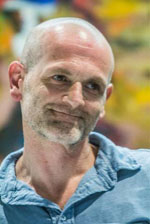
JEFF GUIDO
The title of this panel, American Visions – Alternative Studies threw me at first as alternative is a word with more than one meaning: alternative as another possibility another choice, or alternative as unconventional to challenge traditional norms. In preparation for this panel, when thinking about the title and how it relates to The Clay Studio two alternate thoughts kept running through my head: our programs were not developed as a replacement for more traditional studies in the ceramic arts thus we are not an alternative to those programs. And secondly, the types of programs that we offer at The Clay Studio are similar to those offered by other art centers, thus ours are not alternative but might be viewed as conventional. Both thoughts as stated are completely true (which is when I would start thinking, Why was I asked to be on this panel?). But both fail to tell our entire truth.
The Clay Studio (TCS) has evolved from its origins in 1974 as an artists’ collective into one of the world’s leading ceramic art institutions. We serve a regional audience while maintaining a strong national and international presence. The Studio is known for its artist residencies, international arts exhibitions, professional facilities, high-quality instructors, and innovative programming. We serve a diverse constituency, from practicing artists, beginning students, and underserved children to established collectors, cultural tourists and the general public. This program mix allows us to serve our local audience, program for a national audience, and act as a catalyst for international understanding and appreciation of the ceramic art field. The Clay Studio currently organizes itself in six distinct program areas, all of which help to activate our hands-on educational mission.
The Studio’s most public programs are its Exhibition Galleries and Shop. Here we provide the public with an opportunity to purchase and live with new ceramic works. Collectors can find important pieces to add to their collections, students and resident artists can be exposed to new techniques, and the artists on display are given an opportunity to make a living. The Shop represents over 100 of North America’s finest makers of functional pots, cups, plates, and vases. Our exhibitions, more than 20 each year, are known as a showcase of innovative, diverse contemporary work. Exhibitions include current trends in the field, clay in combination with mixed media and new media as well as work rooted in centuries-old traditions. Though emphasis is placed on emerging talent, mid-career and established artists are included too. In line with our desire to have both a local and international balance, one year’s exhibition programming will include a Claymobile Exhibition, focusing on local children’s work, a juried National Graduate Student Exhibition and an exhibition of new work by eight makers from Japan. Both programs reflect the vision of The Clay Studio as a premiere center of talent in the field of ceramics and strive to expand participants understanding of clay as a material, its physical and practical properties and the endless means of expression possible through its use, and the ideas behind the work on display, the conceptual content. Annually 25,000 individuals visit our bricks and mortar space viewing the exhibitions produced, and/or partake in the ancillary educational programs developed in conjunction with them. Additionally 100,000 individuals experience our programs virtually, our website receiving over a million page views annually.
Our school focuses on active learning and experimentation through classes, workshops, and special events. We present four seasonal sessions of coursework (10 weeks in length), appealing to the beginner, intermediate, and the advanced student. Based on audience research, we have greatly expanded our “one-off” hands-on workshops and shorter 5-week courses, aligning with current participation trends. In 2011, we also began offering the Local Artist Workshop Series (LAWS), which provides participants with a daylong specialty workshop given by a local Master Artist. Many of our instructors have advanced fine arts degrees and/or decades of teaching experience. Students access a clean & well-maintained facility, 17 fully functioning gas & electric kilns, a glaze lab, a school store, and a knowledgeable group of staff & interns. Last year our school and workshop programs served over 2,300 students.
Our Associates Program is, in many ways, an extension of our school. This program is tailored to those who become serious enough about clay that they want to continue making art in a self-directed model. For these individuals, ranging from hobbyist to professional, we offer 24-hour access to a communal facility, equipment, and educational programming. The Associates Program has space for 40 individuals and currently has 36 active participants (90% occupancy). In an effort to reach young artists, we offer 13 additional slots as a Work Exchange (Intern) Program. In exchange for one day of work per week, the Work Exchange intern receives free rent in the Associates Program, reduced-cost materials and firings, and opportunities for professional development. We continue to expand the education opportunities for the Associates with free workshops and other professional development opportunities.
A jewel in our educational and community-service mission is an innovative outreach program known as The Claymobile™. Founded by The Clay Studio in 1994, this is a 100% mobile program consisting of two fully stocked vans that each travel to partner sites throughout the Greater Philadelphia (and New Jersey) region. Each year, we partner with approximately 75 sites including schools, community centers, homeless shelters, and youth detention centers. The Claymobile curriculum is not a traditional “arts and crafts activity” but focuses on the highest educational standards in fine arts, the humanities, science, and social studies. Our artist-educators fashion an engaging curriculum with host partners to present age-appropriate lessons in the arts, sciences, and humanities, with the goal of bringing a hands-on component to existing program goals and established academic standards. Sample Claymobile™ programs have included field trips to dig clay and learn about the geology of clay deposits, plant impressions to learn about the process of fossilization, mask making to learn about various cultures like Ancient Egypt or Mesoamerica, and bird sculptures to learn about avian biology. Of course, in many residencies we also teach participants how to make mugs, bowls, vases, and other traditional clay objects. In 2012, the program staff expanded to two full time professionals in order to expand community partnership opportunities and program strength.
Claymobile outreach classes reach some of the most disadvantaged populations in Philadelphia, providing creative experiences for 1,750 students annually at no cost or below cost. Sadly our program is no longer an alternative to our School Systems arts programming. The public school system in Philadelphia, like many public school systems across the United States has faced and continues to face huge financial challenges reaching a projected billion-dollar deficit by 2017. Arts programs typically top the lists of those programs considered expendable and have been cut from many schools curricula making the interaction students have with our Claymobile their only opportunity for a creative arts experience.
Our Resident Artist Program is a programmatic bridge from our local Philadelphia service area out to the national and international field of ceramics and craft. This program provides twelve emerging artists with no cost studio space, exhibition and teaching opportunities, new networks, and individualized mentoring. Each artist may elect to stay for up to five (5) years – the longest ceramic residency program in the field. This year, we had two (2) available spaces in the program and we received 74 residency applications. This year’s applicant pool included artists from Denmark, Canada, Korea, and England, reflecting an increasingly international draw for our program. Through a professional jury process, consisting of current residents, one outside juror and myself, we have maintained extremely high selection standards. The success of this program is clearly demonstrated in the success of our Resident alumni who go on to win prestigious artistic awards and residencies, highly coveted jobs in academia and contribute to the field through gallery representations and participation in important shows nationally and internationally.
Our program is unlike any in the Country, truly focusing on the individual needs of each participant. The Resident’s studio space is located in the heart of a major metropolitan city, with all that has to offer, our proximity to New York, Baltimore, Boston and Washington DC serving our Residents well. There is no curriculum as this is not school, no rules regarding hours worked, the demands made by The Studio of each of them purposefully kept to a minimum. But expectations of them are high. There is nothing idyllic about the program as it mirrors the reality that each individual who chooses to be a visual artist must face; how difficult the life they have chosen is, how their formal education has inadequately prepared them for the world they are now a part of, and in trying to achieve that balance between what they want to do and what they have to do to survive. The program provides no financial support other than their free studio spaces, the teaching and exhibition opportunities available to them, are not a given and must be earned. Our Residents are entitled to nothing other than the experience and guidance of my TCS colleagues and myself when asked for. It is contingent upon them to define their goals and ultimately achieve them with the staff of The Studio here to provide guidance and support. This is not a Residency program that provides a break from the realities of their daily existence but alternatively a program that equips them with the tools, experience and understanding necessary to excel in their chosen profession.
For more than twenty years, The Clay Studio has supported the talents of international makers in ceramics through it Guest Artist-in-Residence Program and in the production of nine international exhibitions. Prior to the Studio’s exhibitions of international ceramics, they were rarely seen in the U.S. due to the cost of shipping and relatively low sales prices. Since opening that door, it has become more common across the country at like facilities. Our previous international exhibitions focused on maker’s works from Eastern Europe, Taiwan, Israel, Hungary, Puerto Rico, England, Canada, China, and in 2011, Japan.
Our Guest Artist-in-Residence Program has hosted individuals from over 40 countries. Each is provided an apartment, studio space, a materials and firing stipend and monthly living stipend, with most Guests stays two months in length. This program has provided wonderful opportunities for our students to witness the creative process of these gifted makers first hand, this international focus adding greatly to the artistic diversity of our entire community.
Thank You.
Jeff Guidio
is Artistic Director of the Clay Studio, Philadelphia
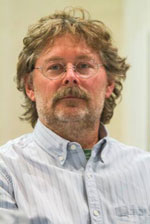
DOUG CASEBEER
Anderson Ranch Residency Program was created in 1985. The Residency was designed to provide artists with focused time for open exploration and experimentation in a supportive studio setting. Resident Artists use the Ranch space and facilities for conceptual development, a rigorous studio practice and interaction with other resident artists. We encourage intellectual and personal growth.
One of the characteristics that most distinguishes humans is creativity. Creativity and artistic development have been celebrated at the Ranch for 50 years. The Ranch impacts and actively changes the lives of everyone who takes a workshop, attends our artist lectures, is a visiting artist or spends time in our studios as an artist in resident.
Artists and art making are at the heart of the Ranch’s mission. The Ranch embraces the notion that creative development comes from the freedom to explore and take risks in a supportive studio experience. The Ranch brings people together through an art experience. We are committed to positive social change in our lives through art making.
All of the Ranch’s facilities, equipment and scholarships have come through the generosity of donors, foundations and individual artist support. Every year over 1100 students participate in 140 workshops, with 28 emerging and established artists taking part in our fall and spring residencies. Emerging Artists typical have less than 10 years of experience in the field with no major exhibitions. Established Artists are those who have a career in the arts field with an exhibition record and at least 10 years of experience. The Ranch puts a very high value on its equipment, facilities and technical support.
Anderson Ranch Residencies are offered to artists who want to advance their current art, create new ideas or study a different media. Multi-disciplinary approaches are encouraged. The Ranch Residency is an intentional community with a rigorous studio practice. Ranch Residents are highly motivated artists. The Ranch requires no degrees or university experience, just a desire to make art.
There are no specific qualifications for the residency program. Awards and selections are given to those who in the exclusive opinion of an independent jury of established artists, have submitted the best art work possible.
The primary goal of the Ranch Residency Program is to provide the space, time and resources for emerging and established artists to create and refine their art in a community of interaction, conceptual development, and intense production. We provide studio space, housing, and meals.
The Ranch Residency is an artist’s gift to themselves of time and space.
While in residence, artists are given 24 hour access to their studio. Artistic staff and visiting artists are available for studio critiques. Each residency session includes two visiting critics for residents to access. The opportunity to interact within a community of artists working together is a unique aspect of Ranch residencies. Artists work independently, setting their own studio schedule. The Ranch environment is designed to support artists in taking risks with as little outside pressure as possible. An important element of the program is the social and professional interaction between resident artists.
Past Visiting Artists, have included Grogory Amenoff, David Kimball Anderson, Terry Allen, Jean Blackburn, Eddie Dominguez, Arthur Gonzalez, Jane Hammond, David Hillard, Benjamin Lira, Charles Long, Julie Mehretu, Brad Miller Jeanne Quinn, James Surls, Ursula von Rydingsvard, Judy Pfaff, Stan Welsh and Stepen Westfall, just to name a few. Annually Japanese Master Potter Takashi Nakazato is in residence for 2 to 3 months, working along side resident artists.
Currently the Ranch underwrites a portion of all 28 residents, which includes 4 fully funded awards. The residency fee is $1500. The residency program provides artists with 10 weeks of full access to all of the Ranch facilities. Artists are given the opportunity to explore new media and materials, as well in engage with important and critical art conversations.
The Ceramics facility includes 3 wood kilns, 2 soda kilns, 3 gas kilns and 9 electric kilns. There are extruders, pugmill, mixers, wheels and an extensive glaze lab available to resident artists. Also available to all residents is a full wood shop, a full metal shop and digital/media lab.
The Ranch’s goal for the Residence Program is to invite emerging and established artists worldwide. The Ranch strives to create a community of artists that reflects a rich mix of artistic styles with ethnic, social and human diversity. The Ranch actively seeks artists from all backgrounds and walks of life.
Recent assessment of the Ranch Residency Program indicates a broad professional impact in the visual arts world. Former Ranch Resident’s artwork is in over 115 permanent collections including The Fine Arts Museum of San Francisco, The Smithsonian and The Guggenheim Museum. Ranch Resident Artists teach in over 119 art schools through out the country including Rhode Island School of Design, Michigan State University, Columbia University, University of Tennessee, Montana State University, Yale University and Sierra Nevada College. Ranch Resident Artists have won major awards in the visual arts including the Guggenheim Fellowship, Fulbright Scholarships, and NEA awards. The Ranch receives annually over 400 applications for 28 available residencies.
Past Resident Artists have come from Australia, Brazil, Hong Kong, Chile, Croatia, Canada, France, South Africa, India, Iran Japan, Jamaica, Korea, Netherlands, Spain, Taiwan, the USA and more.
Unique characteristics of the Ranch Residency Program are: 1. A beautiful Alpine location, with a remarkable natural landscape in the Rocky Mountains, 2. A first class studio facilities with expert technical staff, 3. A rigorous interdisciplinary studio environment with opportunities to explore and excel in different media and materials and 4. A rich and dynamic artistic community of Aspen, Snowmass and the Roaring Fork Valley of Colorado.
Why would an artist choose a residency program: 1. To have a pivotal or seminal experience that increases the scope of their artist knowledge and critical thinking, 2. To engage and impact artistic dialogue worldwide, 3. To be a leader and innovator in the arts, 4. To change artists lives and those around them, “make a difference in society”, 5. To be an arts advocate that impacts positive social change, 6. To engage in a network of cultural diverse artists, 7. To be part of a community that invigorates their studio practice through research and experimentation, and 8. To be part of a dynamic artistic community.
The Anderson Ranch is committed to a studio practice of artistic discovery. The Ranch nurtures the process of exploration through experimentation. We believe that diverse exposure equals creative diversity. The Ranch mentors young emerging artists into a professional practice. The Ranch mentors established artists into new realms of artistic discovery.
Thank you
Doug Casebeer
Chair – Artist in Residency Program
Artistic Director – Ceramics, Wood and Sculpture
Resources.
Anderson Ranch Arts Center
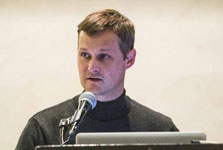
TYLER GULDEN
Watershed’s Mission is to provide serious artists with time and space to create in clay.
Watershed is a residency/retreat which provides artists with time and space to create in clay. We serve artists from across the country and abroad. Watershed’s unique niche grows out of its small and intimate communal approach to a non-hierarchical, process-oriented environment for experimentation, exploration, collaboration and growth.
Watershed serves the local community with a variety of clay arts programs. We teach community classes in clay for adults and children statewide through our Mudmobile, hold clay workshops for people with special needs, collaborate with other non-profit organizations to offer learning opportunities through art, and hold public lectures and events to open Watershed’s studio environment and present artists for interaction with the local community.
Watershed programs offer short term self-directed opportunities to live and work in a small, non-hierarchical group environment.
The history of Watershed begins with the geological gift of clay which is found along the banks of the local rivers of mid-coast Maine. For much of the 19th century, making waterstruck brick, so called because it was made from a wet mixture of clay and water, was a popular and vital source of income for the local community. Waterstruck brick had such historical appeal that in 1974, an attempt was made to re-establish its manufacture in Edgecomb at the Watershed Brick and Clay Products Company. Unfortunately, high production costs and insufficient demand necessitated the closing of the facility after only one year of operation.
Inspired by an idea, Margaret Griggs, an artist and investor in the brick factory, enlisted artists George Mason, Lynn Duryea and Chris Gustin in 1986 to organize a pilot project to utilize the site in a new way. Twelve artists from the United States and Britain came to live and work in the facility over the course of the summer. That fall, a second group of artists comprised of students and graduate faculty from the Ceramics Department of the Swain School of Design were invited to live and work for ten days at the former brickyard. The rustic and open-ended aspects of the facility encouraged the artists to approach their work with a new vigor and awareness. As a result, an enlightened community of artists came together to establish Watershed’s philosophy and shape its future.
Watershed’s Residency Program includes several unique artist-in-residence opportunities and durations during the year. Every two weeks, June-August, Watershed accommodates up to twenty artists per session who work, eat, and live in our intimate community setting; for six weeks during the fall up to eight artists live and work at Watershed; the Salad Days Artist is in residence three months during the summer. The opportunity for artists to live and work together in a non-structured and unique environment attracts most participants.
The Watershed experience encourages and nurtures the exchange of ideas, collaboration, experimentation, exploration, and self-inquiry. A place of intrepid and authentic creative inquiry, Watershed is not a teaching or workshop oriented program. Artists are expected to work independently, though there is no expectation that an artist produce work while in residence. Artists, while in residence, often make discoveries that they were unprepared to make; discoveries that would otherwise not have been made had they not decided come to Watershed.
The residency program includes artists with a range of experience and career levels, from students and emerging artists to those decades into their work, representing a range of aesthetics and processes, and a range of those using clay as a primary medium to those using clay as an adjunct to their principal material.
Watershed has opportunities for artists of all levels and financial means. Support through assistantships and juried funded residencies are available for the summer sessions.
Every resident at Watershed enjoys a discounted residency fee - in order for Watershed to make residency opportunities available to as many artists as possible the actual cost of each residency at Watershed is subsidized to some extent. A portion of all funds raised by Watershed events, and annual and endowed giving go toward supporting the artists-in-residence all year round.
1100+ resident artists – including 65 artists from 19 countries
Past resident artists include: Scott Chamberlin (CO), Jim Melchert(CA), Julia Galloway(MT), Nan Smith (FL), Wouter Dam (Netherlands), Ester Beck (Israel), Jack Troy (PA), Meredith Host (MO), Tara Wilson (MT), Tim Rowan (MT), Nancy Selvin (CA), Eddie Dominguez (NM), Jim Lawton (MA) among others.
Tyler Gulden is Executive Director at Watershed
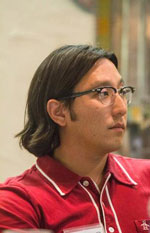
STEVEN YOUNG LEE
The Archie Bray Foundation for the Ceramic Arts is a public, nonprofit, educational institution founded in 1951 by brickmaker Archie Bray, who intended it to be "a place to make available for all who are seriously and sincerely interested in any of the branches of the ceramic arts, a fine place to work." Its primary mission is to provide an environment that stimulates creative work in ceramics.
Listed on the National Register of Historic Places, the Bray is located three miles from downtown Helena, Montana, on the site of the former Western Clay Manufacturing Company. Set against the wooded foothills of the Rocky Mountains, the 26-acre former brickyard is internationally recognized as a gathering place for emerging and established ceramic artists. The nearby mountains and brick factory ruins provide a backdrop for the creative environment; more important is the dynamic arts community created by the resident artists that come to the Bray to work, share experiences, and explore new ideas.
History of the Foundation
The Archie Bray Foundation for the Ceramic Arts is located in Helena, Montana, on the grounds of what was once Western Clay Manufacturing Co. brick manufacturing company. Bray, an avid patron of the arts, envisioned an art center and built the Pottery in the spring of 1951, the first step in his dream to "make available for all who are seriously interested in the ceramic arts, a fine place to work."
Rudy Autio and Peter Voulkos were the first resident managers of the Bray. The volume and quality of their work drew attention to the new program and attracted many talented and ambitious potters. A landmark workshop in 1952, with potters Shoji Hamada and Bernard Leach, and philosopher Soetsu Yanagi, had a profound influence on both Autio and Voulkos. Neither had seen clay treated so loosely and freely. It was an approach which changed their whole attitude towards clay.
Since its inception, the Bray has drawn hundreds of ceramic artists from around the world to work, including such well-known ceramists as Akio Takamori, Kurt Weiser, Patti Warashina, Val Cushing, John and Andrea Gill, Wayne Higby, Clary Illian, Jun Kaneko, Eva Kwong, Jim and Nan McKinnell, Ron Meyers, Robert Sperry, Chris Staley, Akio Takamori, Matt Metz and Linda Sikora among many others.
Directors Ken Ferguson, David Shaner, and Dave Cornell worked hard at the Bray in the 1950s, 60s, and 70s, to establish a sound financial base by selling pots, clay, and ceramic supplies, and by offering classes and workshops. Kurt Weiser's tenure as Resident Director at the Bray from 1977 to 1988 saw an expansion of the clay business with Chip Clawson as manager, and a successful fundraising effort to purchase the brickyard after it closed in 1960. Carol Roorbach became Resident Director in 1989, establishing a permanent endowment. Roorbach also initiated procedures for improved storage and documentation of the extensive and growing Bray permanent collection.
Josh DeWeese became Resident Director in 1991, and worked to establish a Resident Artist Scholarship fund which helps residents to enjoy studio space rent-free. In addition, the Bray now offers a growing number of resident artist fellowships which provide annual stipends for juried resident artists, and the Peter Voulkos Fellowship Fund supports an annual visiting artist award to a prominent, world-renowned ceramic artist to work at the Bray.
The Bray also successfully completed a $2.5 million capital campaign to construct a new state-of-the-art resident studio facility, expand endowment and strengthen annual operations.
Upon Josh's retirement in 2006, Steven Young Lee was hired as the Resident Artist Director, and continues the work of upgrading facilities for resident artists and expanding workshop and exhibitions programs. In 2009 the Bray completed a comprehensive kiln project that greatly improved firing efficiency and increased the firing options by introducing new technologies and allowing for greater scale of work.
Current Long-Term Resident Artists
Andrew Gilliatt, Virginia Beach, VA, 2012-2013 Speyer Fellow
Mel Griffin, Rochester, MN, 2012-2013 Taunt Fellow
Peter Christian Johnson, La Grande, OR, 2012-2013 Matsutani Fellow
Chris Pickett, Chattanooga, TN, 2012-2013 MJD Fellow
Nicholas Bivins, Orinda, CA, 2010-2011 Matsutani Fellow
Jeff Campana, Verona, WI, 2011-2012 Anonymous Fellow, 2012-2013 Windgate Fellow
Alanna DeRocchi, Petersburg, IL, 2011-2012 Speyer Fellow, 2012-2013 Windgate Fellow
Kenyon Hansen, Channing, MI, 2011-2012 Lincoln Fellow
Steven Young Lee, Helena, MT, Resident Artist Director
Sean O'Connell, Fayetteville, AR, 2011-2012 Matsutani Fellow, 2012-2013 Windgate Fellow
Jonathan Read, Phoenix, AZ, 2011-2012 Lilian Fellow, 2012-2013 Windgate Fellow
Bray Resident Directors
Rudy Autio, 1951–1957
Peter Voulkos, 1951–1954
Lillian Boschen, 1951–1952
Gene Bunker, 1957–1958
Ken Ferguson, 1958–1964
David Shaner, 1964–1970
Dave Cornell, 1970–1976
Kurt Weiser, 1976–1988
Carol Roorbach, 1989–1992
Josh DeWeese, 1992–2006
Steven Young Lee, 2006-present
Steven Young Lee is Director of the Archie Bray Foundation |